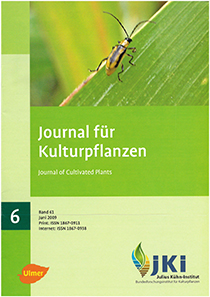Studies on the processing of <em>B.t</em>.-toxins Cry3Bb1 and Cry34Ab1/Cry35Ab1 in the midgut of Western corn rootworm
DOI:
https://doi.org/10.5073/JfK.2009.06.01Keywords:
Western corn rootworm, Diabrotica virgifera virgifera LeConte, B.t.-corn, B.t.-toxins, Cry3Bb1, Cry34Ab1/Cry35Ab1, resistance mechanisms, gut juice, gut epithelium, pH value, protease activity, proteolytic processing, binding analysesAbstract
The Western corn rootworm is one of the most economically important pests in corn worldwide. One possibility for controlling this pest is the cultivation of B.t.-corn. However, widespread cultivation of B.t.-corn may increase the probability of the development of pest populations resistant to the respective B.t.-toxins. To establish test systems for the identification of resistance mechanisms in the case of resistance development, different parameters involved in the processing of B.t.-toxins in the midgut of Western corn rootworm third instars larvae were studied.
For the identification of proteases in the midgut juice and quantification of their activities photometrical tests were conducted. Due to the acid midgut juice of the Western corn rootworm (pH 5.75), mainly proteases with acidic pH optimum were expected. Accordingly, high activities of the cysteine endopeptidases cathepsin L with papain as well as cathepsin B and cathepsin H were observed. Activity of the aspartic endopeptidase pepsin – a protease with very acidic pH optimum – was detected as well. Furthermore proteases from different classes were identified. Besides the serine endopeptidases trypsin, chymotrypsin, and elastase, proteases of the same class – cathepsin G, plasmin, and thrombin – were identified. In addition, the metallo endopeptidase saccharolysin as well as the exopeptidase aminopeptidase and an omegapeptidase were active in the midgut juice of the Western corn rootworm.
Furthermore, the proteolytic processing of effective B.t.-toxins with Western corn rootworm midgut juice was examined. But neither the 77 kDa toxin Cry3Bb1 nor the binary toxins Cry34Ab1 (14 kDa) and Cry35Ab1 (44 kDa) were processed with midgut juice. Thus, in contrast to the B.t. plant protection agents, the toxins seem to be in an active form.
The Ligand-blot binding analyses with the B.t.-toxins Cry3Bb1 and Cry34Ab1/Cry35Ab1 revealed specific receptors in the WCR midgut epithelium. The molecular weights for Cry3Bb1, Cry34Ab1, and Cry35Ab1 receptors were characterized as having molecular weights of approximately 30 kDa, 110 kDa, and 50 kDa, respectively.
Downloads
Published
Issue
Section
License
The content of the journal is licensed under the Creative Commons Attribution 4.0 License. Any user is free to share and adapt (remix, transform, build upon) the content as long as the original publication is attributed (authors, title, year, journal, issue, pages).
The copyright of the published work remains with the authors. The authors grant the Journal of Cultivated Plants, the Julius Kühn-Institut and the OpenAgrar repository the non-exclusive right to distribute and exploit the work.







